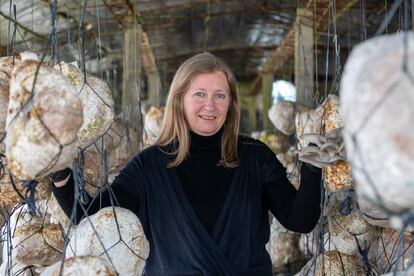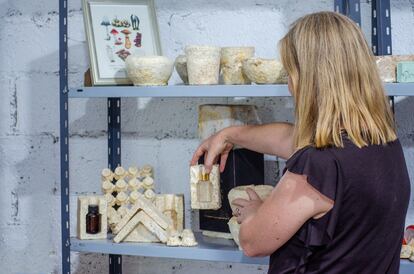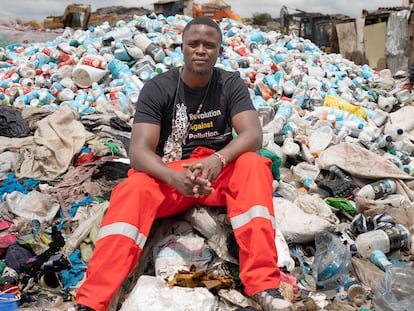Fungi, yerba mate waste and cassava starch: Argentina’s alternatives to plastic
Scientists and entrepreneurs in the country are exploring ways to replace plastic packaging with everyday materials

The cling film around a food tray takes between 500 and 1,000 years to degrade. A similar period is required for the plastic plant pots that decorate a living room, the packaging of a perfume or the box encasing a children’s toy. The polystyrene that covers a newly purchased appliance will need between 100 and 500 years. All of these materials have something in common: they are believed to be among the most polluting elements, they are discarded after only one use and after only a few minutes, and their excessive production has been an issue of concern to the United Nations for years. This organization has warned that its use could increase threefold in the next two decades and calls for the creation of a more sustainable “new plastic economy.”
With the aim of reducing pollution, Argentina is seeing a proliferation of projects to replace single-use plastics by using materials of all kinds. These range from fungi to yerba mate waste, cassava starch and flour, among others. However, the lack of investment and the absence of specific laws to generate greater environmental awareness represent a barrier to progress in developments that could become large-scale and affordable, according to scientists and entrepreneurs who have been working on sustainable initiatives for many years.
Cassava starch and yerba mate waste to manufacture food containers
On a global level, the food industry is one of the largest consumers of single-use plastics, using containers, bottles, disposable trays and cling film, among many others. Focusing on this issue, Lucía Famá, a researcher at the National Scientific and Technical Research Council (CONICET) and coordinator of the Laboratory of Polymers and Composite Materials of the Faculty of Exact Sciences of the University of Buenos Aires, is currently working on dozens of projects to completely eliminate the use of plastics and also on other initiatives to partially replace them.
Famá and her team are pursuing several lines of research. One of these is the development of films from cassava starch and black tea extract and yerba mate waste — two elements that are widely used in Argentina, and which also have natural antioxidant and antibacterial properties. “The material is edible, celiac-friendly and has greater adaptability and shelf life when it comes to preserving food,” she explains.

In other areas of her research, she combines cassava starch with polymers that degrade much faster than conventional polyethylene, even though they are not 100% biodegradable. “These polymers mixed with starch generate a very resistant material, and though they are not edible, they are rapidly biodegradable,” she explains. The scientist points out that they can be used as packaging for any product, but clarifies that the food industry is the main target. “We have plenty of projects in the pipeline, we have other extracts to generate antioxidant materials and we also combine them with nanoparticles that have antimicrobial activity,” she stresses.
Globally, some 430 million metric tons of plastic are produced every year and the forecast is alarming. According to data from the United Nations Development Program (UNDP), “if current trends continue, production will triple by 2060.” In 2021 alone, the world generated 139 million metric tons of plastic waste, the equivalent of 13,700 Eiffel Towers.
In a document entitled Plastics 101, the UNDP stresses that “two-thirds of plastics are ephemeral” and “will soon become litter,” and these include bags, food packaging and bottles. It also calls for new strategies and proposes a “new economy based on plastics” which, in a more sustainable way, could generate 700,000 jobs in the next two decades.
A fungus-based biomaterial
Ayelén Malgraf is a biologist and as a child she first discovered her love for mushrooms when she would go out with her grandfather to collect them and use them in recipes that she still remembers today. Decades later, that passion inspired her to pursue the cultivation of fungi for gastronomic purposes in Cerrillos, in the province of Salta, in northern Argentina. While studying the properties of fungi in her laboratory, she discovered that there were other applications “beyond edible things,” which paved the way for the creation of resistant materials that could replace plastic.
“We sold mushroom growing kits that used coffee as a substrate. When we harvested, we were left with a really hard block, like a brick, that was resistant to water,” she told EL PAÍS. In 2019, together with two partners, she launched Fungipor, a business that manufactures pots, packaging, packets and other design elements that replace plastic, using mushroom mycelium, the material that is “in the leaf litter or dry branches” and that, combined with bean straw, generates a resistant material. “When dried following a specific process, the mycelium acquires the characteristics of a plastic or Styrofoam (polystyrene),” she explains.

Malgraf believes it is important to reduce the amount of plastic produced worldwide. “The packaging industry has grown significantly. By 2030, it is estimated that production will be much higher, and there are hardly any alternatives,” says the biologist and entrepreneur. However, she warns that the industry in her country is not developed, and therefore requires “the support of public policies and laws that oblige producers to be responsible for the management of their waste.”
Malgraf points out that, in addition to being a biodegradable material, it has fireproof and acoustic properties, it is lightweight and, thanks to its resistance, it provides good protection against knocks and falls.
Laws, regulations and investment: the challenges of the future
Famá welcomes the state’s investment to finance this type of research, although she clarifies that it is also necessary for the private sector to add its share and get involved. “Small and medium-sized companies are the most interested. This is a product under development, not finished, which can be very competitive, not only because of the price, but also because of its functionality, because it allows food to be stored for longer, making it more durable,” she says.
“We have to think about the situation in Argentina and see how it can be applied in a country where the economic situation [makes life harder for] the population. We know that there are many people who have just enough money to make ends meet, and it is difficult for them to think about a change of these characteristics, but if there were investment from companies for large-scale development, a product like this could have very competitive prices,” the researcher adds.
With the recent victory of the ultra-conservative Javier Milei, who will be sworn in as the country’s president this Sunday, there is still uncertainty as to how these initiatives will be financed, and it is still unknown who will be in charge of important policy areas such as science, technology and the environment. During the electoral campaign, Milei anticipated budget cuts across the board and affirmed that projects such as this one should be financed by the private sector, which would have a detrimental effect on ongoing research. In fact, Famá fears that her laboratory will be defunded and that her research will be truncated due to the lack of resources.
Malgraf, on the other hand, points to the need for “laws that force companies to take care of the environment.” Although she points out that there are some companies interested in following a more sustainable production model, she clarifies that there is still “a long way to go.” “In Chile, there is a Producer Responsibility Law, which obliges producers to take responsibility for the waste they generate. A similar law would be necessary” in Argentina, she says.
Sign up for our weekly newsletter to get more English-language news coverage from EL PAÍS USA Edition
Tu suscripción se está usando en otro dispositivo
¿Quieres añadir otro usuario a tu suscripción?
Si continúas leyendo en este dispositivo, no se podrá leer en el otro.
FlechaTu suscripción se está usando en otro dispositivo y solo puedes acceder a EL PAÍS desde un dispositivo a la vez.
Si quieres compartir tu cuenta, cambia tu suscripción a la modalidad Premium, así podrás añadir otro usuario. Cada uno accederá con su propia cuenta de email, lo que os permitirá personalizar vuestra experiencia en EL PAÍS.
¿Tienes una suscripción de empresa? Accede aquí para contratar más cuentas.
En el caso de no saber quién está usando tu cuenta, te recomendamos cambiar tu contraseña aquí.
Si decides continuar compartiendo tu cuenta, este mensaje se mostrará en tu dispositivo y en el de la otra persona que está usando tu cuenta de forma indefinida, afectando a tu experiencia de lectura. Puedes consultar aquí los términos y condiciones de la suscripción digital.
More information
Archived In
Últimas noticias
Sydney Sweeney, the actress praised by Trump: ‘Women are up against what society wants them to be’
The Bolsonaro surname: An advantage or liability in Brazil’s 2026 presidential elections?
Raúl Rocha, from jet-setting with Miss Universe to arms trafficking and fuel theft
80,000 barrels of Mexican oil sent to Cuba: Havana drawn into the US–Mexico clash
Most viewed
- Reinhard Genzel, Nobel laureate in physics: ‘One-minute videos will never give you the truth’
- Pablo Escobar’s hippos: A serious environmental problem, 40 years on
- Charles Dubouloz, mountaineering star, retires at 36 with a farewell tour inspired by Walter Bonatti
- Why we lost the habit of sleeping in two segments and how that changed our sense of time
- The fall of a prolific science journal exposes the billion-dollar profits of scientific publishing









































